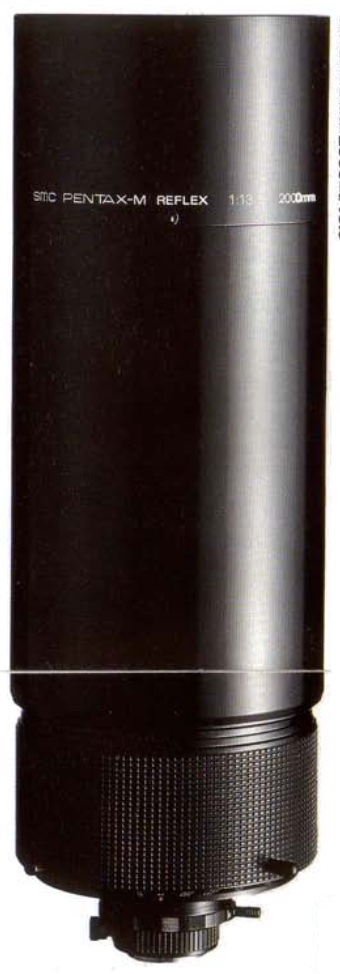smc Pentax-M 2000mm F/13.5 Reflex
Super telephoto prime lens • Film era • Discontinued
- Announced:
- · 1982
- Production status:
- ● Discontinued
- Country of design:
- · Japan
- Original name:
- · ASAHI OPT. CO. SMC PENTAX-M REFLEX 1:13.5 2000mm
- Class:
- · Ultra-slow full-frame super telephoto prime lens
- · Mirror/Reflex lens
- System:
- · Pentax K (1975)
Abbreviations
| SMC | Multi-layer anti-reflection coating is applied to the surfaces of lens elements. This anti-reflection coating increases light transmission, eliminates flare and ghosting, and maintains color consistence among all lens models. |
| M | A manual focus lens with automatic maximum aperture indexing, which is a mechanical system for coupling the lens to the camera's exposure system. More compact and lighter than the standard K-series counterpart, but with no sacrifice in quality of construction, resolution, durability or contrast. Learn more |
Model history (2)
| ■smc Pentax 2000mm F/13.5 Reflex | -- | 6 - 4 | 20.00m | -- | 1978 ● | |
| ■smc Pentax-M 2000mm F/13.5 Reflex | -- | 6 - 4 | 20.00m | -- | 1982 ● | |
Specification
| Optical design: | |
| 35mm full frame | |
| 2000mm | |
| F/13.5 | |
| 6 elements in 4 groups | |
| Pentax K [45.5mm] | |
| 1.2° (35mm full frame) | |
| On Pentax K APS-C [1.53x] cameras: | |
35mm equivalent focal length: | 3060mm (in terms of field of view) |
35mm equivalent speed: | F/20.7 (in terms of depth of field) |
Diagonal angle of view: | 0.8° |
| Diaphragm mechanism: | |
Diaphragm type: | Fixed |
Aperture control: | None |
| Focusing: | |
| 20m | |
| 1:8.33 | |
Focusing modes: | Manual focus only |
Manual focus control: | Focusing ring |
| Physical characteristics: | |
| 8000g | |
| ⌀180×530mm | |
| Accessories: | |
| Removable front filters are not accepted | |
| Built-in Neutral, Skylight, Y2, R2 (part of the lens optical system) | |
| Rear screw-type 52mm | |
| Built-in telescopic round | |
| Pentax Rear Converter-A 2X-S → 4000mm F/27 |
Sources of data
- Manufacturer's technical data.
- Pentax 35mm SLR lenses (September 1989).
- Pentax 35mm SLR lenses.
- Pentax MG booklet (PUB. 06221) (July 1983).
- Pentax cameras booklet (PUB. 06091, 40 pages) (March 1987).
- Pentax SLR cameras booklet (PUB. 050101) (September 1988).
- Pentax cameras booklet (PUB. 06091, 32 pages).
- Pentax ZX-M booklet.
- Pentax lenses and accessories booklet (PUB. 08051).
- Pentax lenses & accessories - A Comprehensive and Versatile Photographic System booklet.
Manufacturer description #1
The reflex optical design of this super telephoto makes possible a dramatic reduction in the size of the lens. Besides reducing size, the use of mirrors in the design eliminates the need for optical correction and makes possible an extremely close minimum focusing distance. Since the reflex design does not allow a lens diaphragm, light control is accomplished by means of three built-in ND (neutral density) filters and shutter speed variation. The lens is equipped with built-in standard filters and sight.
Manufacturer description #2
Despite its extremely powerful telephoto effects, this lens offers a dramatically reduced size and a close minimum focusing distance thanks to a reflex optical design which incorporates two mirror elements. The M Reflex 2000mm F/13.5 features the longest focal length among all SMC Pentax lenses. Exposure is controlled by means of three built-in ND (neutral density) filters and shutter speed variation. It also features three built-in filters (skylight, Y2 and R2).
Pentax-M series
The second generation of lenses designed for Asahi Pentax 35mm SLR cameras with bayonet mount. Introduced with Asahi Pentax ME and MX in 1976.
- Miniaturized lenses with average 20% less weight and length than their standard SMC counterparts, but with no sacrifice in quality of construction, resolution, durability or contrast;
- Robust, all-metal design with recessed focusing distance scale;
- Fully automatic diaphragm;
- Support for TTL open-aperture metering;
- Extremely accurate manual focusing with rubberized focusing ring;
- Multi-layer anti-reflection coating.
Typical characteristics of mirror (reflex) lenses
- Catadioptric system consisting of curved mirrors and optical glass;
- Much shorter, lighter and less expensive designs than conventional super telephoto lenses;
- Outstanding correction of chromatic aberrations;
- Since the aperture is fixed, neutral density filters are used to obtain a smaller aperture;
- Doughnut-shaped out-of-focus highlights.
From the editor
For information on using filters with this lens, please refer to the page dedicated to the Reflex 1000/11.
Other super telephoto prime lenses in the Pentax K system
| ■Pentax K mount (2) | |||||||||
| smc Pentax 1000mm F/11 Reflex | -- | 6 - 4 | 8.00m | -- | 1977 ● | ||||
| smc Pentax 2000mm F/13.5 Reflex | -- | 6 - 4 | 20.00m | -- | 1978 ● | ||||
